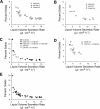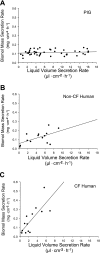Mucous solids and liquid secretion by airways: studies with normal pig, cystic fibrosis human, and non-cystic fibrosis human bronchi
- PMID: 21622844
- PMCID: PMC3154629
- DOI: 10.1152/ajplung.00388.2010
Mucous solids and liquid secretion by airways: studies with normal pig, cystic fibrosis human, and non-cystic fibrosis human bronchi
Abstract
To better understand how airways produce thick airway mucus, nonvolatile solids were measured in liquid secreted by bronchi from normal pig, cystic fibrosis (CF) human, and non-CF human lungs. Bronchi were exposed to various secretagogues and anion secretion inhibitors to induce a range of liquid volume secretion rates. In all three groups, the relationship of solids concentration (percent nonvolatile solids) to liquid volume secretion rate was curvilinear, with higher solids concentration associated with lower rates of liquid volume secretion. In contrast, the secretion rates of solids mass and water mass as functions of liquid volume secretion rates exhibited positive linear correlations. The y-intercepts of the solids mass-liquid volume secretion relationships for all three groups were positive, thus accounting for the higher solids concentrations in airway liquid at low rates of secretion. Predictive models derived from the solids mass and water mass linear equations fit the experimental percent solids data for the three groups. The ratio of solids mass secretion to liquid volume secretion was 5.2 and 2.4 times higher for CF bronchi than for pig and non-CF bronchi, respectively. These results indicate that normal pig, non-CF human, and CF human bronchi produce a high-percent-solids mucus (>8%) at low rates of liquid volume secretion (≤1.0 μl·cm(-2)·h(-1)). However, CF bronchi produce mucus with twice the percent solids (~8%) of pig or non-CF human bronchi at liquid volume secretion rates ≥4.0 μl·cm(-2)·h(-1).
Figures






References
-
- Aikawa T, Shimura S, Sasaki H, Ebina M, Takishima T. Marked goblet cell hyperplasia with mucus accumulation in the airways of patients who died of severe acute asthma attack. Chest 101: 916–921, 1992 - PubMed
-
- Anderson MP, Gregory RJ, Thompson S, Sousa DW, Paul S, Mulligan RC, Smith AE, Welsh MJ. Demonstration that CFTR is a chloride channel by alteration of its anion selectivity. Science 253: 202–205, 1991 - PubMed
-
- Ballard ST, Trout L, Mehta A, Inglis SK. Liquid secretion inhibitors reduce mucociliary transport in glandular airways. Am J Physiol Lung Cell Mol Physiol 283: L329–L335, 2002 - PubMed
-
- Boucher RC, Narvarte J, Cotton C, Stutts MJ, Knowles MR, Finn AL, Gatzy JT. Sodium absorption in mammalian airways. In: Fluid and Electrolyte Abnormalities in Exocrine Glands in Cystic Fibrosis, edited by Quinton PM, Martinez JR, Hopfer U. San Francisco, CA: San Francisco Press, 1982, p. 271–287
Publication types
MeSH terms
Substances
Grants and funding
LinkOut - more resources
Full Text Sources
Other Literature Sources
Medical

